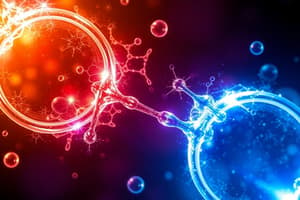Podcast
Questions and Answers
What is formed when one or more electrons are transferred from one atom to another?
What is formed when one or more electrons are transferred from one atom to another?
- Metallic Bonds
- Ionic Bonds (correct)
- Puase Bonds
- Covalent Bonds
What is the definition of Covalent Bonds?
What is the definition of Covalent Bonds?
- Form from pooled electrons
- Do not involve electrons
- Formed when electrons are shared between atoms (correct)
- Formed through electron transfer
Which term refers to the elements of Group 1 of the periodic table?
Which term refers to the elements of Group 1 of the periodic table?
- Halogens
- Alkali Metals (correct)
- Noble Gases
- Transition Metals
Which group on the periodic table contains the Halogens?
Which group on the periodic table contains the Halogens?
What do Noble Gases have in common?
What do Noble Gases have in common?
What is an Electron Dot Diagram?
What is an Electron Dot Diagram?
Define an Isotope.
Define an Isotope.
Sodium Bromide is represented by the chemical formula ___
Sodium Bromide is represented by the chemical formula ___
Lithium Oxide is represented by the chemical formula ___
Lithium Oxide is represented by the chemical formula ___
What is the formula for Phosphate?
What is the formula for Phosphate?
What is the formula for Sodium Phosphate?
What is the formula for Sodium Phosphate?
Calcium Chloride's formula is ___
Calcium Chloride's formula is ___
What is the formula for Magnesium Sulfide?
What is the formula for Magnesium Sulfide?
Aluminum Fluoride is represented by the chemical formula ___
Aluminum Fluoride is represented by the chemical formula ___
What is the formula for Potassium Nitrate?
What is the formula for Potassium Nitrate?
Ammonium Chloride's formula is ___
Ammonium Chloride's formula is ___
What is the charge of an ionic bond?
What is the charge of an ionic bond?
What charge is associated with a molecular bond?
What charge is associated with a molecular bond?
What is an Ion?
What is an Ion?
Ionic compounds are solid at room temperature.
Ionic compounds are solid at room temperature.
What is a Single Bond?
What is a Single Bond?
Define a Double Bond.
Define a Double Bond.
What is a Triple Bond?
What is a Triple Bond?
Flashcards are hidden until you start studying
Study Notes
Ionic Bonds
- Formed through the transfer of electrons from one atom to another, resulting in charged ions.
- Characterized by the attraction between positively and negatively charged ions.
Covalent Bonds
- Occur when atoms share electrons, allowing them to attain stability.
- Shared electrons can be in single, double, or triple bonds based on how many pairs are exchanged.
Metallic Bonds
- Develop when metal atoms pool their electrons, enabling conductivity and malleability.
- Results in a "sea of electrons" that facilitates sharing among many metal atoms.
Alkali Metals
- Comprise Group 1 of the periodic table, includes lithium, sodium, potassium, rubidium, cesium, and francium.
- Highly reactive metals, especially with water, forming strong bases and hydrogen gas.
Halogens
- Found in Group 17 of the periodic table, consisting of fluorine, chlorine, bromine, iodine, and astatine.
- Highly reactive nonmetals that readily form salts with alkali metals.
Noble Gases
- Reside in Group 18 of the periodic table, includes helium, neon, argon, krypton, xenon, and radon.
- Known for their lack of reactivity due to a full valence electron shell.
Electron Dot Diagram
- A visual representation indicating the valence electrons of an atom as dots surrounding the element's symbol.
- Helps understand bonding and electron configuration.
Isotope
- Variants of the same element that contain different numbers of neutrons, leading to different atomic masses (e.g., Carbon-12, Carbon-13, Carbon-14).
- Isotopes can be stable or radioactive and have various applications in medicine and research.
Common Chemical Compounds
- Sodium Bromide (NaBr): Composed of sodium and bromide ions, commonly used in medical applications.
- Lithium Oxide (Li₂O): An important compound used in ceramics and batteries.
- Phosphate (PO₄³⁻): A polyatomic ion essential in biology and various biochemical processes.
- Sodium Phosphate (Na₃PO₄): Used in food and industrial applications as a pH regulator.
- Calcium Chloride (CaCl₂): Often used for de-icing roads and as a desiccant.
- Magnesium Sulfide (MgS): Utilized in the production of ceramics and fertilizers.
- Aluminum Fluoride (AlF₃): Important in aluminum production and catalyst in organic chemistry.
- Potassium Nitrate (KNO₃): Historically used in fertilizers and food preservation.
- Ammonium Chloride (NH₄Cl): Employed in fertilizers, food, and in some pharmaceutical products.
Ionic Compounds
- Typically solid at room temperature, indicative of strong ionic bonds.
- Neutral overall charge; composed of positively charged cations and negatively charged anions.
Molecular Bonds
- Characterized by slight charges due to uneven sharing of electrons, can lead to polar molecules.
Ions
- Formed when an atom gains or loses electrons, leading to a charged particle (positive or negative).
Types of Bonds
- Single Bond: Involves the sharing of a single pair of electrons between two atoms.
- Double Bond: Involves two pairs of electrons shared between two atoms, increasing bond strength.
- Triple Bond: Involves sharing of three pairs of electrons, resulting in a strong connection between atoms.
Studying That Suits You
Use AI to generate personalized quizzes and flashcards to suit your learning preferences.




